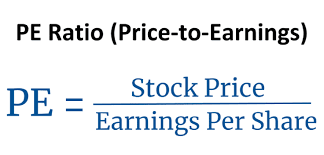The Price-to-Earnings ratio (P/E/A/R) is a popular financial indicator used by investors to determine the fair market value of a business. It’s a great way to see how investors see a company’s growth and profitability. This article will go into the P/E ratio, including its definition, how it’s calculated, and some real-world applications.
What is the P/E ratio?
The price-earnings ratio (P/E/A/R) is a basic metric that measures the value of a stock according to its per-share earnings. It indicates how much money investors are ready to part with in exchange for a dollar of the company’s profits. When the P/E ratio is high, investors are bullish on the company’s potential for future profit growth, while when it’s low, they’re more pessimistic.
The formula for calculating the P/E ratio
The formula for determining the P/E ratio is simple. The ratio is calculated by dividing the stock price by the company’s earnings per share (EPS). Its mathematical form is as follows:
P/E Ratio = Market Price per Share / Earnings per Share (EPS)
If a stock is selling for $50 per share and earning $2 per share in profit, the P/E ratio is 25 (50/2).
Interpreting the P/E ratio
The P/E ratio is difficult to decipher without additional knowledge about the company’s sector, development forecasts, and market circumstances. When the P/E/A/R is high, it usually means that investors are optimistic about the company’s future profits. However, the P/E ratio of a company is only useful when compared to similar businesses in the same industry.
It’s possible that the firm is undervalued or having financial troubles if its P/E ratio is low. But it might also mean investors are worried about the company’s future or management’s ability to maintain steady profit levels.
Importance of the P/E ratio for investors
As a measure of a stock’s worth and prospective growth, the P/E/A/R is a crucial metric for investors to use. Investors might find promising investment possibilities by analyzing the P/E ratios of various firms. Also shown are the market’s mood and the level of confidence investors have in a given stock.
The price-earnings ratio (P/E) is a popular metric used by investors to judge whether a company is overpriced, underpriced, or fairly priced. Investment choices should be made using this method in addition to other fundamental analytical techniques.
Factors affecting the P/E ratio
The P/E ratio of a firm may be affected by a number of different variables. Among these are:
- Industry dynamics: The P/E ratio may change depending on the industry, as different sectors have differing amounts of development potential and risk. When comparing technology firms with utility firms, for instance, the former often have higher P/E ratios.
- Growth prospects: It is common practice to attribute a greater P/E ratio to companies thought to have a brighter future. Companies with above-average profit growth expectations get a higher price from investors.
- Market conditions: Stock P/E ratios are susceptible to market sentiment and macroeconomic variables. Due to increasing uncertainty and risk aversion, P/E ratios may fall during economic downturns or market corrections.
Examples of P/E ratios in different industries
Let’s look at some real-world data to see how P/E/A/R have varied across sectors:
- Technology Industry: The P/E ratios of technology companies, which are expected to develop rapidly, tend to be higher than those of companies in other industries. A high P/E ratio of 40, for instance, would suggest that investors have a lot of faith in the future profitability of a renowned software business.
- Utility Industry: The P/E ratios of technology companies, which are expected to develop rapidly, tend to be higher than those of companies in other industries. A high P/E ratio of 40, for instance, would suggest that investors have a lot of faith in the future profitability of a renowned software business.
- Retail Industry: Depending on their expected rate of development and the current state of the market, retail businesses’ price-to-earnings ratios may fluctuate. It’s not uncommon for the P/E ratio of a rapidly expanding e-commerce firm to be 50, while that of a more staid brick-and-mortar store to be 12.
Limitations of the P/E ratio
The P/E ratio is a helpful indicator, but it has its limitations. When analyzing investments with the P/E ratio, it’s crucial to keep in mind certain caveats:
- Industry comparisons: Comparing the P/E/A/R to similar businesses in the same sector might yield useful information. It might be misleading to draw comparisons between the P/E ratios of, say, a technology firm and a utility firm.
- Accounting differences: Earnings estimations, and hence the P/E ratio, are susceptible to variations due to differences in accounting principles and procedures. When comparing P/E ratios, it is essential to examine the quality of underlying profits and to guarantee uniformity in accounting practices.
- Cyclical industries: Earnings in cyclical businesses are vulnerable to the ups and downs of the economy. The P/E ratio may be inadequate as a standalone indicator of a company’s profitability.
Conclusion
The P/E/A/R is a useful indicator of how the market values a company’s future profits. It’s a tool that aids in the valuation of stocks and the discovery of promising investment possibilities. Investment decisions should be made with this and other financial analysis tools in hand.
Investors may learn more about the value and growth potential of a firm by familiarizing themselves with the P/E ratio and how it is calculated.
Frequently Asked Questions (FAQs)
What is a good P/E ratio?
A good P/E ratio depends on various factors, including the industry, growth prospects, and market conditions. Generally, lower P/E ratios are considered more favorable for value investors, while higher P/E ratios may indicate growth opportunities.
Can the P/E ratio be negative?
Yes, the P/E/A/R can be negative when a company reports negative earnings. However, negative P/E ratios are less common and require further analysis to understand the reasons behind negative earnings.
Is a high P/E ratio always a good sign?
Not necessarily. A high P/E ratio can indicate market confidence and growth expectations, but it can also imply an overvalued stock. It is essential to consider other factors and conduct a comprehensive analysis before making investment decisions.
How often should I analyze the P/E ratio of a company?
The frequency of analyzing the P/E ratio depends on your investment strategy and the specific company’s circumstances. It is generally recommended to review the P/E ratio periodically, especially when there are significant changes in the company’s financial performance or market conditions.
Can the P/E ratio be used for comparing companies from different industries?
Comparing P/E ratios across different industries may not provide accurate insights. Industries have different growth rates,
Are you passionate about sharing your insights and expertise? We invite you to write for us! Whether you’re a seasoned writer or just starting out. We’re looking for fresh perspectives on a variety of topics, from lifestyle and wellness to technology and travel.
 Lifeyet News Lifeyet News
Lifeyet News Lifeyet News





